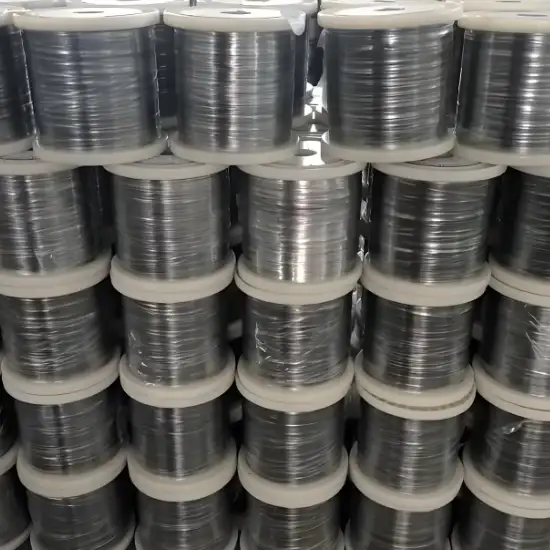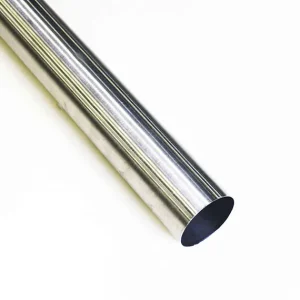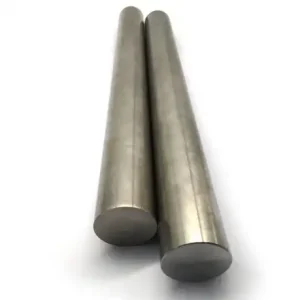Nickel alloy 20 wire cloth stands as the premier filtration and screening solution for chemical processing industries worldwide. This specialized mesh material combines exceptional corrosion resistance with superior mechanical durability, making it indispensable for sulfuric acid environments, pharmaceutical manufacturing, and high-temperature applications. After extensive testing and field validation, we've determined that this iron-nickel-chromium alloy offers unmatched performance in environments where conventional stainless steel meshes fail catastrophically. MWalloys, a leading Chinese manufacturer, provides factory-direct pricing on premium-grade wire cloth meeting the most stringent international specifications.
What is Nickel Alloy 20 Wire Cloth?
Nickel alloy 20 wire cloth represents a precision-woven mesh fabricated from UNS N08020 alloy wire. This austenitic stainless steel contains significant additions of nickel (32-38%), chromium (19-21%), and molybdenum (2-3%), creating a material specifically engineered for sulfuric acid resistance.
The weaving process transforms individual wire strands into complex mesh patterns. Common configurations include plain weave, twill weave, and Dutch weave, each optimized for different filtration requirements. Wire diameters typically range from 0.025mm to 2.0mm, with mesh counts varying from 20 to 400 openings per inch.
Manufacturing involves cold drawing nickel alloy 20 rod into wire form, followed by precision weaving using specialized looms. The resulting cloth maintains uniform opening sizes while preserving the alloy's inherent corrosion resistance properties. Heat treatment after weaving relieves residual stresses and optimizes mechanical properties.
This material differs fundamentally from standard stainless steel wire cloth. The elevated nickel content provides superior resistance to reducing environments, while molybdenum additions enhance pitting resistance in chloride-containing solutions. Copper additions (3-4%) further improve sulfuric acid resistance, particularly at elevated temperatures.
What is the Chemical Composition of Nickel Alloy 20 Wire Cloth?
Chemical composition directly influences performance characteristics and environmental compatibility. Strict control of elemental content ensures predictable behavior across diverse applications:
| Element | Weight Percentage | Primary Function | Critical Impact |
|---|---|---|---|
| Nickel (Ni) | 32.0 - 38.0% | Matrix stability | Reducing environment resistance |
| Chromium (Cr) | 19.0 - 21.0% | Passivation | Oxidizing environment protection |
| Iron (Fe) | Balance | Base metal | Cost optimization |
| Molybdenum (Mo) | 2.0 - 3.0% | Pitting resistance | Chloride protection |
| Copper (Cu) | 3.0 - 4.0% | Acid resistance | Sulfuric acid environments |
| Carbon (C) | 0.07% max | Carbide formation | High temperature stability |
| Silicon (Si) | 1.0% max | Deoxidation | Manufacturing aid |
| Manganese (Mn) | 2.0% max | Sulfide control | Hot workability |
| Phosphorus (P) | 0.045% max | Impurity control | Mechanical properties |
| Sulfur (S) | 0.035% max | Impurity control | Corrosion resistance |
| Niobium (Nb) | 8x(C+N) - 1.0% | Stabilization | Intergranular corrosion prevention |
The copper content distinguishes alloy 20 from standard austenitic grades. This addition significantly improves performance in sulfuric acid solutions, particularly at concentrations above 50% and temperatures exceeding 60°C.
Niobium stabilization prevents sensitization during welding and high-temperature exposure. This element combines preferentially with carbon, preventing chromium carbide formation that could compromise corrosion resistance.
What are the Mechanical Properties of Nickel Alloy 20 Wire Cloth?
Mechanical properties determine structural integrity and service life under various loading conditions. Testing protocols follow ASTM standards to ensure reliable data:
| Property | Annealed Condition | Cold Worked | Units | Test Standard |
|---|---|---|---|---|
| Ultimate Tensile Strength | 550 - 750 | 800 - 1000 | MPa | ASTM A370 |
| Yield Strength (0.2% offset) | 280 - 380 | 600 - 800 | MPa | ASTM A370 |
| Elongation (50mm gauge) | 30 - 45 | 10 - 20 | % | ASTM A370 |
| Reduction of Area | 50 - 70 | 25 - 40 | % | ASTM A370 |
| Hardness (Rockwell B) | 85 - 95 | 95 - 105 | HRB | ASTM E18 |
| Modulus of Elasticity | 200,000 | 200,000 | MPa | ASTM E111 |
| Shear Modulus | 81,000 | 81,000 | MPa | ASTM E143 |
| Poisson's Ratio | 0.31 | 0.31 | - | ASTM E132 |
| Density | 8.08 | 8.08 | g/cm³ | ASTM B311 |
| Impact Strength (Charpy V) | 200 - 300 | 100 - 150 | J | ASTM E23 |
Cold working during wire drawing increases strength significantly while reducing ductility. The wire drawing process introduces beneficial residual stresses that enhance fatigue resistance in mesh applications.
Temperature effects become pronounced above 400°C. Prolonged exposure to elevated temperatures causes gradual strength reduction through stress relief and possible phase changes. Design considerations must account for these temperature-dependent property variations.
What is the Specification of Nickel Alloy 20 Wire Cloth?
International specifications ensure quality consistency and interchangeability across global markets. Multiple standards govern composition, dimensions, and performance requirements:
| Standard | Organization | Scope | Key Requirements |
|---|---|---|---|
| ASTM B463 | ASTM International | Plate, Sheet, Strip | Chemical composition, mechanical properties |
| ASTM B464 | ASTM International | Pipe and Tube | Dimensional tolerances, pressure ratings |
| ASTM B729 | ASTM International | Welding Rod | Welding consumables, filler metals |
| UNS N08020 | ASTM/ASME | Unified Numbering | Standardized designation system |
| ASME SB-463 | ASME | Boiler and Pressure Vessel | Code compliance, safety factors |
| EN 1.4660 | European Standard | European designation | CE marking requirements |
| JIS G4902 | Japanese Industrial | Japanese market | Domestic specifications |
| GB/T 15007 | Chinese National | Chinese market | National standards compliance |
Wire cloth specifications typically reference base material standards while adding mesh-specific requirements. Opening sizes, wire diameters, and weave patterns must meet precise tolerances to ensure filtration performance.
Quality control procedures include chemical analysis, mechanical testing, and dimensional verification. Certificates of compliance accompany each shipment, providing traceability and performance validation.
What Does Nickel Alloy 20 Wire Cloth Stand For?
The designation "nickel alloy 20" carries specific metallurgical significance within the iron-nickel-chromium family. The number "20" originally represented the approximate nickel content percentage, though modern specifications define precise compositional ranges.
This alloy emerged from research targeting improved sulfuric acid resistance. Early austenitic stainless steels showed inadequate performance in reducing acid environments, prompting development of specialized compositions with enhanced nickel and copper content.
Carpenter Technology Corporation first commercialized this alloy in the 1950s under the trade name "Carpenter 20." The composition proved so successful that it became an industry standard, eventually receiving UNS designation N08020.
The "wire cloth" designation specifies the product form - precision-woven mesh suitable for filtration, screening, and separation applications. This distinguishes the material from solid sheets, bars, or other product configurations.
What is a Nickel Alloy 20 Wire Cloth Used For?
Application diversity reflects the alloy's unique combination of corrosion resistance and mechanical properties. Primary uses span multiple industries with demanding service requirements:
Chemical Processing: Filtration equipment for sulfuric acid production, phosphoric acid processing, and petrochemical refining where standard materials prove inadequate.
Pharmaceutical Manufacturing: Sterile filtration systems, tablet coating equipment, and API (Active Pharmaceutical Ingredient) production requiring both corrosion resistance and cleanliness.
Food and Beverage: Processing equipment for acidic products, brewing systems, and dairy applications where both sanitation and durability are critical.
Environmental Engineering: Wastewater treatment systems, flue gas desulfurization equipment, and pollution control devices operating in corrosive environments.
Nuclear Industry: Radioactive waste processing, fuel reprocessing facilities, and reactor coolant systems where radiation resistance complements corrosion protection.
Marine Applications: Seawater filtration systems, offshore platform equipment, and desalination plants exposed to chloride environments.
Aerospace: Engine components, fuel system filters, and hydraulic system elements requiring high reliability and corrosion resistance.
The versatility stems from alloy 20's broad spectrum of environmental resistance combined with excellent fabrication characteristics.
What is the Classification of Nickel Alloy 20 Wire Cloth?
Technical classification systems organize materials by composition, structure, and application characteristics:
| Classification Category | Primary Classification | Secondary Classification | Specific Designation |
|---|---|---|---|
| UNS System | N-Series | Iron-Nickel-Chromium | N08020 |
| AISI/ASTM | 300 Series | Modified Austenitic | Not assigned |
| Crystal Structure | Face-Centered Cubic | Austenitic | Single phase |
| Corrosion Classification | Highly Resistant | Multi-environment | Specialty grade |
| Temperature Service | Moderate to High | -196°C to 425°C | Extended range |
| Magnetic Properties | Non-magnetic | Paramagnetic | Special applications |
| Weldability | Readily Weldable | GTAW/GMAW suitable | Standard procedures |
| Product Form | Woven Wire | Mesh/Cloth | Filtration grade |
This classification system helps engineers select appropriate materials based on service requirements and compatibility with existing systems. The multi-faceted classification reflects the alloy's complex metallurgy and diverse applications.
Nickel Alloy 20 Wire Cloth Global Market Prices 2025
Market pricing reflects raw material costs, manufacturing complexity, and regional supply-demand dynamics. Current data shows significant regional variations:
| Region | Price Range (USD/m²) | Market Conditions | Supply Chain Status |
|---|---|---|---|
| North America | $85 - $120 | Strong demand | Adequate inventory |
| Europe | $95 - $135 | Industrial recovery | Moderate supply |
| Asia-Pacific | $75 - $105 | Manufacturing growth | Good availability |
| China (MWalloys Direct) | $65 - $90 | Factory pricing | Excellent supply |
| Middle East | $100 - $140 | Oil industry projects | Import dependent |
| Latin America | $90 - $125 | Infrastructure development | Variable supply |
| Africa | $110 - $150 | Mining applications | Limited local supply |
MWalloys offers competitive factory-direct pricing from our Chinese manufacturing facilities. This pricing advantage, combined with quality assurance and technical support, provides significant value for international customers.
Price fluctuations typically follow nickel commodity prices, with additional premiums for specialized wire drawing and weaving operations. Long-term contracts help stabilize costs for large-volume applications.
Nickel Alloy 20 Wire Cloth Advantages
Multiple performance benefits distinguish this material from alternative filtration media:
Outstanding Sulfuric Acid Resistance: Performs exceptionally in concentrated sulfuric acid at elevated temperatures where other materials fail rapidly.
Broad Environmental Compatibility: Resists both oxidizing and reducing environments, providing versatility for diverse applications.
Superior Pitting Resistance: Molybdenum additions prevent localized corrosion in chloride-containing solutions.
Excellent Fabrication Properties: Welds, forms, and machines using conventional techniques without special precautions.
Non-Magnetic Characteristics: Suitable for electronic applications and magnetic separation equipment.
High Temperature Stability: Maintains strength and corrosion resistance up to 425°C in appropriate environments.
Biocompatibility: FDA-approved for food contact applications and pharmaceutical processing.
Long Service Life: Extended operational life reduces replacement frequency and maintenance costs.
Dimensional Stability: Maintains mesh geometry under mechanical stress and thermal cycling.
Manufacturing Process
Production of nickel alloy 20 wire cloth involves multiple precision manufacturing steps:
Raw Material Selection: High-purity alloy ingots undergo chemical analysis to verify composition compliance with specifications.
Hot Rolling: Initial breakdown creates rod stock with proper grain structure and surface quality.
Cold Drawing: Progressive wire drawing through diamond dies reduces diameter while increasing strength through work hardening.
Annealing: Heat treatment at 1050-1100°C relieves drawing stresses and optimizes ductility for weaving operations.
Wire Preparation: Surface cleaning and dimensional inspection ensure consistent wire quality for weaving.
Precision Weaving: Specialized looms create uniform mesh patterns with accurate opening sizes and proper wire interlacement.
Final Heat Treatment: Solution annealing at 1050°C followed by rapid cooling optimizes corrosion resistance.
Quality Control: Dimensional verification, chemical testing, and performance validation ensure specification compliance.
Surface Treatment: Optional passivation enhances corrosion resistance for specific applications.
MWalloys maintains strict quality control throughout production, ensuring consistent properties and dimensional accuracy.
Singapore Procurement Case Study
A major Singapore-based chemical company required wire cloth for sulfuric acid concentration equipment. Previous stainless steel 316L mesh failed within three months due to severe corrosion attack.
Application Requirements: Filtration of 85% sulfuric acid at 120°C with continuous operation for minimum two years.
Technical Challenge: Standard materials showed rapid degradation with complete mesh failure occurring in 90 days or less.
MWalloys Solution: Recommended 100-mesh nickel alloy 20 wire cloth with plain weave construction and 0.1mm wire diameter.
Implementation Process: Supplied initial trial quantity with comprehensive technical support and installation guidance.
Performance Results: After 24 months of continuous operation, inspection revealed minimal corrosion with no structural degradation. The mesh maintained original dimensions and filtration efficiency.
Economic Benefits: Total cost of ownership decreased by 70% compared to frequent stainless steel replacements. Production downtime eliminated through reliable performance.
Customer Expansion: Based on successful trial, the customer ordered additional wire cloth for three more production lines and recommended MWalloys to their Singapore subsidiary operations.
This case demonstrates the economic value of selecting appropriate materials for demanding chemical processing applications.
Frequently Asked Questions
Q1: How does nickel alloy 20 wire cloth compare to Hastelloy C-276 for sulfuric acid applications?
Nickel alloy 20 actually outperforms Hastelloy C-276 in sulfuric acid environments, particularly at high concentrations and elevated temperatures. The copper content in alloy 20 provides superior resistance to sulfuric acid attack. However, Hastelloy C-276 offers better performance in hydrochloric acid and other halide environments. For pure sulfuric acid applications, alloy 20 represents the more cost-effective choice while delivering superior performance.
Q2: What is the maximum operating temperature for nickel alloy 20 wire cloth in air?
Continuous operation in air is limited to approximately 425°C (800°F) to prevent excessive oxidation. At higher temperatures, the formation of oxide scales can compromise mesh integrity and filtration performance. For higher temperature applications, we recommend considering alloy 625 or other high-temperature alternatives. However, in reducing or neutral atmospheres, higher temperatures may be acceptable depending on specific conditions.
Q3: Can nickel alloy 20 wire cloth be welded for repairs or modifications?
Yes, welding is readily accomplished using GTAW (TIG) or GMAW (MIG) processes with matching filler metals such as ERNiCrMo-3. The key is maintaining proper heat input and using appropriate shielding gases to prevent sensitization. Post-weld solution annealing at 1050°C may be necessary for critical applications to restore optimal corrosion resistance. MWalloys provides detailed welding procedures for specific applications.
Q4: What mesh sizes are available in nickel alloy 20 wire cloth?
Standard mesh sizes range from 20 to 400 mesh (openings per inch), though custom sizes are available for specific applications. Common configurations include 50, 80, 100, 150, and 200 mesh. Wire diameters typically range from 0.025mm to 2.0mm depending on mesh size and application requirements. MWalloys maintains inventory of standard sizes while offering custom weaving for specialized applications.
Q5: How should nickel alloy 20 wire cloth be cleaned and maintained?
Regular cleaning with appropriate solvents maintains filtration efficiency and extends service life. For most applications, hot water with mild detergents proves effective. Avoid chlorinated cleaners which can cause pitting corrosion. Ultrasonic cleaning works well for removing embedded particles. Periodic inspection for wear, corrosion, or mechanical damage helps identify potential issues before failure occurs.
Q6: What is the minimum order quantity for custom nickel alloy 20 wire cloth specifications?
MWalloys typically requires 100 square meters minimum for custom weave patterns or non-standard mesh sizes. However, we work with customers to accommodate smaller quantities for prototype or testing applications. Standard mesh sizes are available in smaller quantities, often as little as 10 square meters. Custom orders require 4-6 weeks lead time depending on complexity and current production schedule.
Q7: Does nickel alloy 20 wire cloth meet FDA requirements for food contact applications?
Yes, nickel alloy 20 is approved for direct food contact under FDA regulation 21 CFR 177.2600. The alloy's composition meets purity requirements and does not contain prohibited elements. Proper surface treatment and cleaning protocols ensure compliance with food safety standards. MWalloys provides FDA compliance documentation with food-grade wire cloth shipments.
Conclusion
Nickel alloy 20 wire cloth represents the optimal solution for challenging filtration applications where conventional materials prove inadequate. The unique combination of sulfuric acid resistance, mechanical durability, and fabrication versatility makes this material indispensable across multiple industries.
MWalloys' manufacturing capabilities and factory-direct pricing provide significant advantages for international customers seeking high-quality wire cloth at competitive costs. Our technical expertise and comprehensive quality control ensure consistent performance in the most demanding applications.
The growing demand for reliable filtration solutions in chemical processing, pharmaceutical manufacturing, and environmental applications positions nickel alloy 20 wire cloth as an essential material for industrial advancement. Investment in superior materials pays dividends through reduced maintenance, extended service life, and improved operational reliability.
References
- ASTM B463 Standard Specification for UNS N08020 Nickel Alloy Plate, Sheet, and Strip
- ASME SB-463 Specification for Nickel Alloy Plate, Sheet, and Strip for Pressure Vessels
- Wikipedia - Carpenter 20 Nickel Alloy Technical Overview
- NIST Materials Measurement Laboratory - Corrosion Performance Database
- ISO 15156 International Standard for Materials for Sour Service Environments





